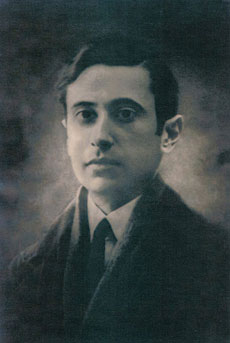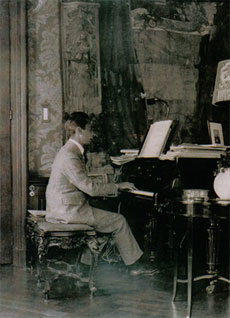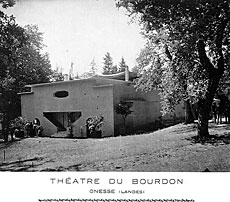Claude Duboscq was born in Bordeaux on July 15th, 1897, is the last one of a family of six children. His family belongs to the upper middle class of Bordeaux. Antoine Duboscq, his father, is a solicitor who owns about 3.000 hectares of pines in Les Landes (France). His forestry operations as well as the business of the railroad sleepers, which he manages with his two brothers René and Camille, supply to the " Company Duboscq Frères " a quite confortable income.
Claude is brought up in a very pious and catholic environment. Antoine Duboscq, who is very generous, quickly becomes aware of the exceptional gifts of his son and he will foster as much as he can his cultural and musical blooming.
Claude starts to play piano at the age of 3. He gives his first auditions at the age of 5 and creates his first compositions at 11. He decodes with passion and wants to assimilate a maximum of musical repertoire.
As a real artist, he has no ambition to become virtuoso. In spite of the music class of all kinds that he learns, he’s still a self-taught in the spirit. Throughout his career, Claude will always prefer the direct teachings of Music Master rather than the study of the theoretical works.
His first musical emotions are provoked by Wagner, which he hears in Bayreuth and Munich. In 1912, at 15-year-old, Claude experiences his first drama: his mother, with whom he had developed a symbiotic relationship, dies. In 1916, Antoine leaves Bordeaux and settles down at Onesse-Laharie (Landes). Claude dreams to learn to master the organ and wishes to go to Paris to work with Vincent d' Indy (1851 - 1931), a composer whom he admires, in La Schola Cantorum. While preparing his high school diploma, he studies Gregorian Chant, the counterpoint, the fugue, the organ supervised by Master Henri Letocart (alumni of César Franck, organist of Saint-Peter of Neuilly), who introduces him to the great masters of the organ.
The capital opens him new horizons. He starts deep friendship with Albert Roussel, Joseph-Guy Ropartz, Joseph Bonnet, Ricardo Viñès.
The World War I breaks out while he is on holidays at Onesse. During winter 1914-1915 he composes, then to the dismay of his father, he decides to join the Armed Forces at the beginning of 1915. He comes backs home in 1917.
Antoine Duboscq, who wishes to keep his son by his side, promises to offer him a Great Organ. That’s why he builds a big room of music endowed with a magnificent triple keyboards organ. The house of Onesse is given the name of an organ game, « Le Bourdon ».
During a concert in Paris, Claude meets his future wife, the pianist Philippe-Marie Keller. They get married next year, on April 12th, 1921. They will have six children. During his honeymoon in Grenada, Claude is received by Manuel de Falla (on 1876 - 1946), one of his correspondents who encourage him to work on religious music.
The friends of his wife presented him two literary talents: Charles Guérin and Francis Jammes who will become the godfather of Gilles Duboscq, 3rd son of Claude and Philippe-Marie.
The couple moves to Onesse into a secondary wing called " The Chalet ".
In 1922, Claude meets the sculptor Henri Charlier (on 1882 - 1975), former friend of Charles Péguy, who took up residence in Mesnil Saint-Loup near Troyes. It is the beginning of a long friendship backed by his convictions and religious aspiration. Henri Charlier will become the godfather of Michel Duboscq, 2nd son of Claude and Philippe-Marie Duboscq.
Claude Duboscq sets up slowly his inseparable musical language from his religious thoughts. He has a big admiration for Rameau, Fauré, Ravel, Debussy and more specially Erik Satie, for " its tremendous effort to free music of secular habits ". He has a pronounced taste for free rhythm: " I compose straight from breath and voice, according to a vocal rhythm, according to an emotion producing a voice vibration, controlled by thought and the verb ". He refuses virtuosity in the field of religion and looks for simple, uncluttered music.
He only writes for piano and organ, song and organ, song and the piano, etc.
His favourite interpreter is the famous opera singer Jane Bathori (1877-1970) that Claude discovered in 1913 during a concert where he was the piano player. Bathori is profoundly impressed and seduced by Claude Duboscq’s great aura. "Shortly before her death, in 1970, the opera singer let us know her feeling that Duboscq is one of the rare composers who seemed to be a true genius."
His instinct urges him to innovate. He thinks of creating a new shape of expression, which would mix gesture, word and music, a kind of synthesis of all arts, " a work inherent to religion ".
" Duboscq attended one day the spectacle of the famous " Russian Ballets ", created in 1919 by Diaghilev, Stravinsky, Satie and Cocteau. But this type of ballet was not focused on faith. What still needs to be done?... That is the question. "
" The defining moment is given by Marie Vassilief, mystic artist member of "fauvist painter”, who suggested to Duboscq to create an entitled Ballet " Divertissement Sacré ". An Ukrainians’ troop of " chorus" and spirit with the " Knights of the Utter destitution " had to performed it to the Champs-Elysées Theatre during a charity evening for the homeless and the needy ".
Claude starts to work with enthusiasm. This trilogy redrew the entire religious history of the world " Before, During, After " (Jesus Christ). Gilbert from the Opera of Berlin was the choreographer. Marie Vassilief created all costumes. Claude managed the Ukrainian chorus of Paris composed of 40 singers.
The title "Bal de la Misère Noire " provoked a resounding outrage. This tactless title sounded like a provocation for the poorer segments of society. Front-page headlines reflect the public's outrage and the show was finally cancelled by Home Secretary, Albert Sarraut. Disappointed but not discouraged, Claude decides in reaction to create another confraternity called "La Pauvreté Claire " and to produce the play at Onesse, Les Landes.
The Performance is held on 5th of February 1928 and played in front 700 spectators. It’s a great success, which encourages him to pursue his efforts. The ‘Bourdon” have never seen as many people as there are during the following years: "The Bourdon buzzes as a hive".
The construction of an open-air theatre leaned in the music room is decided. "Bourdon theatre was intended to become one "Christian Bayreuth" His founder dreamed of developing a kind of new Wagnerism", - i.e. to preserve the mystic aroma of the dramatic Art, to eliminate toxin of a pagan mythology and, to reduce harmonic, musical, vocal and orchestral overload".
The launch of this avant-gardist theatre took place on August 31st, 1930 with Claude’s masterpiece the Colombe-la Petite. Jane Bathori claimed this was its most important work. Colombe-la-Petite is a mystery with entertaining parts as conceived in 18th century with more dramatic, more meaning dance, linked to the drama. "
First sceptical, Henri Ghéon (1875 - 1944), playwright and co-founder of la Nouvelle Revue Française (1909), leaves enthusiastic and greatly seduced. Abbé Gilles Duboscq wrote this: " Christian lyric drama of the 20th century had just found its way. Who was then conscious of it? And nowadays? …"
Antoine Duboscq dies on December 31st, 1930. Claude inherits from the father’s company, but he is not a good businessman. This death is going to be a negative turning point in his artistic life. His father used to play a protective role to the outside world, and especially the members of the Duboscq family who is responsible for the administration matters and business part.
Claude dreams of transforming the Bourdon property into a Dramatic Art School, " … an Art School with boarding students, where we would teach composition, instrumental music, dance, pantomime, lyric and dramatic art ". As underlined by Claude’s wife: " the music room, its Big Organ, a great books and instruments collection were already on site ".
Unfortunately, Claude’s family cut funding and stopped the project. They are strongly opposed to his artistic and ethical expectations and consider that project as " a threat of public scandal or a social degradation". Claude Duboscq, who is frail, experienced then an unrecoverable depression.
To get Claude out of his loneliness, Jane Bathori and Henri Charlier manage to organise a concert tour in Belgium. He plays on organs of Brussels, Antwerp, Mechelen, Leuven, Ghent, Verviers, Liège, …
He is absolutely devastated by the death of his last daughter aged of 18 months. He puts an end to his own life on May 2nd, 1938. He is 40 years old.
He is buried in Mesnil-Saint-loup, next to his close friend Henri Charlier.
His legacy will live for many years to come.
|

![]()



